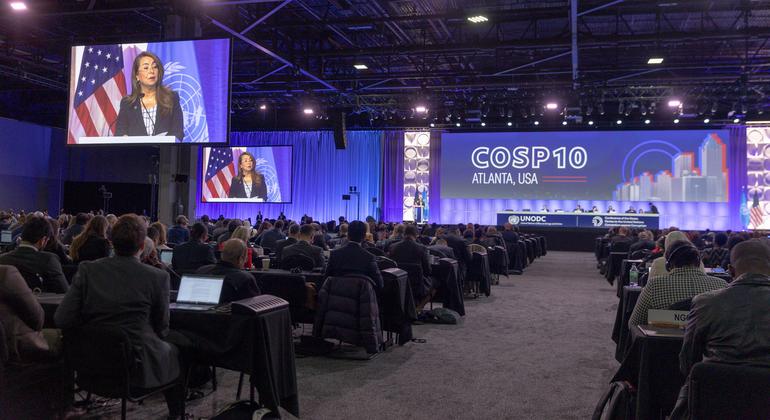This year, the anti-corruption conference, as the Conference of the States Parties (CoSP) is popularly known, marks the 20th anniversary of the landmark Convention.
“Corruption not only robs resources, it robs people of hope,” Mr. Guterres said in a video message, urging all Parties to use this opportunity to strengthen international cooperation to prevent, detect, and prosecute corruption – in partnership with civil society and the private sector.
The week-long conference brings together over 2,000 participants from governments, regional and international organizations, experts as well as private sector and civil society representatives to review progress in implementing the Convention. Delegates will also discuss ways to overcome challenges in implementing UNCAC.
Also speaking at the opening, Ghada Waly, Executive Director of the UN Office on Drugs and Crime (UNODC), hailed the Convention against Corruption as a “monumental” global framework.
“The Convention has become a universal standard and tool that has been the basis for transformative legal and institutional reforms in many countries, as well as international cooperation,” she said.
During the session, States Parties will consider draft resolutions and draft decisions, addressing issues such as measurement of corruption, whistle-blower protection, beneficial ownership transparency, and public procurement, among others.
Acute hunger set to soar globally, warns UN agency

The ongoing war in Sudan has worsened already dire food insecurity in the country.
The UN Food and Agriculture Organization (FAO) warned on Monday that acute hunger is set to soar globally, on the back of “massive underfunding” in agriculture support programmes during times of crisis.
The announcement by FAO was made as part of the launch of the Global Humanitarian Overview, which covers 72 countries impacted by crises, both directly and indirectly.
The UN food security agency said that on average, two-thirds of those experiencing acute food insecurity rely on agriculture for their survival. However, only 4 per cent of total humanitarian funding for food sectors is allocated to emergency agriculture assistance.
“Food crises will continue to dominate the global outlook for 2024,” FAO said, cautioning that further funding squeezes “are expected”, as extreme weather events driven by the climate crisis and El Niño intersect with conflicts and economic instability, pushing more people into hunger.
The UN agency also highlighted the substantial and measurable impact of emergency agricultural interventions in responding to crisis.
For instance, in Afghanistan, FAO supplied wheat packages were not sufficient to meet a family’s yearly needs, but the seeds it provided yield far above the alternatives, the agency said.
With this level of agricultural assistance, combined with food assistance and cash transfers, the number of rural Afghans suffering from high levels of acute hunger fell from 47 per cent among the measured population in May 2022 to 40 per cent in April 2023.
“At a time of global funding cuts, this type of support is both life-saving and cost-effective,” said FAO Deputy Director-General Beth Bechdol, adding “emergency agriculture interventions are life-saving and transformational, and they must be funded.”
Over 370 million unable to afford healthy food in Asia and the Pacific
And staying with food security, a new report by FAO also revealed that more than 370 million people in Asia and the Pacific – about half the world total – are unable to afford healthy diets, with women faring far worse than men.
In Asia and the Pacific Regional Overview of Food Security and Nutrition 2023, launched on Monday, the UN agency noted that the lingering impacts of the COVID-19 pandemic are compounded by the rising cost of a healthy diet.
While the figures of undernourishment varied across countries, southern Asia witnessed the highest prevalence of undernourishment at 15.6 per cent (313.6 million), with over 809 million either moderately or severely food insecure.
While southern Asia accounted for highest number undernourished people by population size, the south-west Pacific islands fared worst per-capita, with about 20.9 per cent of their population, or one in five inhabitants undernourished.
FAO also noted that except for east Asia, women tended to fare worse than men regarding undernutrition, with nearly one-in-ten dealing with severe hunger, while nearly one-in-four women facing at least moderate levels of hunger.
“This report is by no means exhaustive. However, the facts presented serve as food for thought. At the same time, they will not put meals on the table of the many food-insecure and nutritionally vulnerable people living in this part of the world,” said Jong-Jin Kim, Assistant Director-General and FAO Regional Representative for Asia and the Pacific.
“Clearly, there is an urgent call for whole-of-government, well-coordinated and integrated actions and investments towards agrifood systems transformation if we are to turn the tide and put the countries back on track to meeting the 2030 Agenda for Sustainable Development Goals,” he added.



